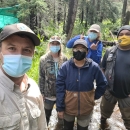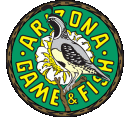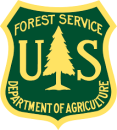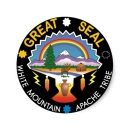Location
States
ArizonaEcosystem
River/streamIntroduction
Apache trout (Oncorhynchus apache) are found only in the waters of the White Mountains in eastern Arizona. It is one of two native trout species in Arizona and is the Arizona state fish. In 1955, the White Mountain Apache Tribe (WMAT) was the first to work toward conserving the species by closing the trout’s habitat to fishing on their lands. The Apache trout was federally listed as Endangered in 1967, and was then downlisted to Threatened in 1975 as a result of restoration efforts. The historical range of this fish includes the White, Black, and the Little Colorado rivers in the White Mountains of east-central Arizona above 5,900 feet. There are currently between 25 and 28 Apache trout populations within their historical range. The U.S. Fish and Wildlife Service is working with the Arizona Department of Game and Fish, the WMAT, and the U.S. Forest Service to recover populations of this species through a combination of stream restoration, captive fish production, and stocking in the White Mountains. The Apache trout population is currently on the rise, with hopes that it will be delisted in the near future.
Key Issues Addressed
The decline of the Apache trout was caused by the introduction of non-native trout species and watershed degradation. Logging, reservoir construction, agriculture, road construction, and mining have reduced and damaged habitat. Introduced brown trout and brook trout prey on Apache trout, posing a direct threat to individuals and populations. These species also compete for resources and habitat. Introduced rainbow trout and cutthroat trout interbreed with native Apache trout, creating hybrids that are no longer representative of the natural genetic diversity of Apache trout.
Project Goals
- Delist the Apache trout after establishing 30 self-sustaining populations of genetically pure Apache trout
- Establish and maintain barriers to keep invasive fish away from recovery populations
- Sustain separate populations for recovery and recreational sport fishing
- Monitor current populations of pure Apache trout
Project Highlights
A Native Sportfish: Maintaining the species’ status as threatened, or delisting it in the future, makes it possible for the Apache trout to continue as a sportfish in designated areas. This increases public support and funding for recovery efforts because anglers appreciate the opportunity to fish for native fish species in Arizona.
- Removal of Non-Native Trout: Streams can be chemically treated (e.g. Rotenone) to kill non-native fish in streams to be utilized for Apache trout recovery. However, some land management agencies do not allow chemical treatments on their land and waters. In these cases mechanical removal is necessary. Mechanical removal using electrofishing techniques and then netting the fish can take decades of effort and the effectiveness is uncertain. This method is only used in small streams.
- Fish Barriers: Barriers, including natural waterfalls and constructed drop structures, are being made to keep non-native trout species separate from recovery habitats of Apache trout. The barriers must be able to withstand flooding.
- Stocking: Fish are collected from established populations by electrofishing and transported to other streams to stock recovery populations. Fish raised at the Williams Creek National Fish Hatchery are stocked in selected locations for sportfishing.
- Stream Restoration: To restore vegetation and improve water quality in streams, fencing is added to keep livestock and elk out of riparian riparian
Definition of riparian habitat or riparian areas.
Learn more about riparian areas. There are restrictions on land uses that can threaten Apache trout habitat. These activities include livestock grazing, logging, and road construction. - Fish Surveys: Surveys are completed to determine abundance of Apache trout and monitor and remove invasive trout species.
Lessons Learned
Barriers must be built tall enough to prevent passage of nonnative fish during high flow events. Concrete barriers are preferable to gabions (wire baskets filled with rocks) because they are less likely to fail. Runoff events following catastrophic wildfires can also result in large sediment flows that compromise fish barriers.
Mechanical removal is very difficult. Streams need to be small, shallow, and wadeable to allow complete removal of non-native fish. Mechanical removal must be done yearly as part of an ongoing management plan. Chemical removal is more likely to be successful.
Partnerships have been essential in the recovery of Apache trout. This collaboration has allowed for increased and shared funding for recovery efforts and has resulted in larger teams working on recovery efforts, including non-native trout removal.
The designation as a sportfish has been key to public and partner support for Apache trout recovery. The fish is culturally important because the White Mountain Apache Tribe in particular, and the public in general, values native sportfish and they want the trout populations to thrive.
Next Steps
- Complete a Species Status Assessment and subsequent 5-Year Status Review to update our biological understanding of the species and forecast future trends for the populations
- Establish a long-term, multi-agency, cooperative management plan
- Eradicate non-native species from key streams, including the West Fork Black River and Bear Wallow Creek
- Monitor the integrity and effectiveness of fish barriers and repair or enhance them as needed
Funding Partners
US Fish and Wildlife Service, Wildlife and Sport Fish Restoration Program
Resources
- Apache Trout Stocking Article from Arizona Game and Fish
- Apache Trout Article from USFWS
- Western Native Trout Initiative
- Apache Trout Recovery Plan
- USFWS Apache trout Q&A
- Baker and Price. (2019). “Using a Mechanistic Model to Develop Management Strategies to Cool Apache Trout Streams under the Threat of Climate Change.” North American Journal of Fisheries Management (39)5: 849-867.
Case Study Lead Author
Leah Wilson, CART Intern, Northern Arizona University
Suggested Citation
Wilson, L.M. (2020). “Working toward Recovery of Apache Trout in Arizona.” CART. Retrieved from https://www.fws.gov/project/recovery-apache-trout.









